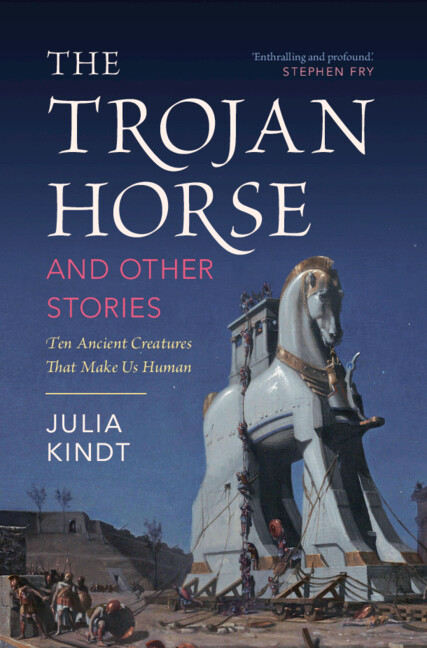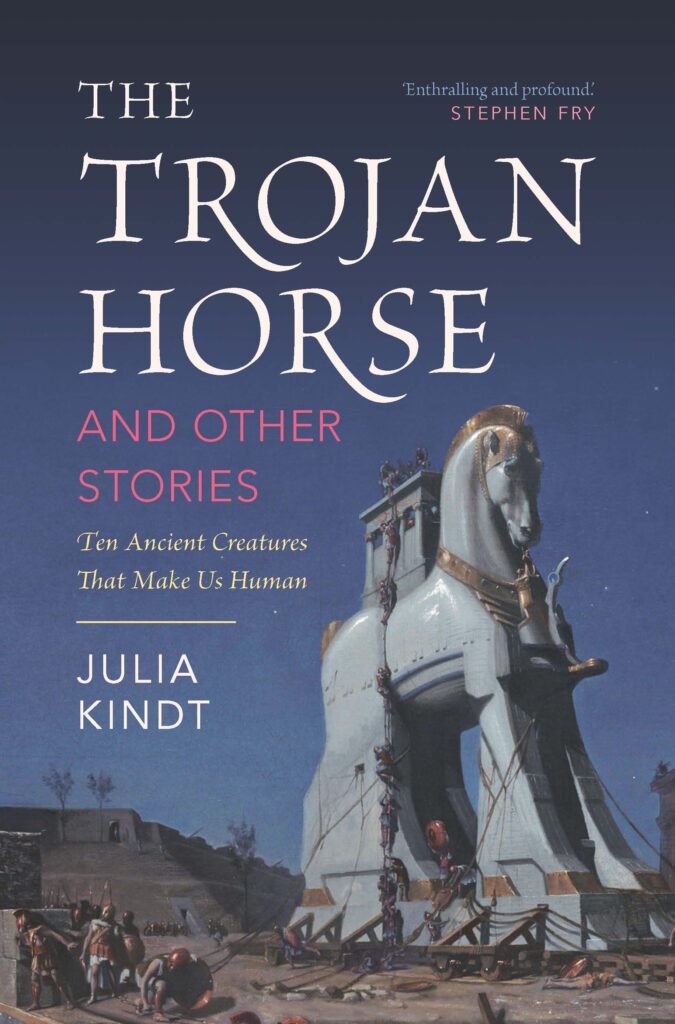What makes us human? What (if anything) sets us apart from all other creatures? Ever since Charles Darwin’s theory of evolution, the answer to these questions has pointed us back to our own animal nature. Yet the idea that, in one way or another, our humanity is entangled with the non-human has a much longer and more venerable history. In the West, it goes all the way back to Classical antiquity, to Greek and Roman views about humans and animals.
In The Trojan Horse and Other Stories: Ten Ancient Creatures that Make Us Human, I show that it is our entanglements with non-human animals that define our humanity. Each chapter tells the story of one ancient creature whose identity sits uneasily between human and animal: the Sphinx, Xanthus (the talking horse of Achilles), the lion of Androclus, the Cyclops, the Trojan Horse, the ‘Trojan’ Boar (a Roman dish), the Socratic gadfly (a figure of speech used by Socrates in his day at court), the political bee, the Minotaur, and the Shearwaters of Diomedea (a species of bird that shows a very peculiar behaviour, welcoming Greeks visiting their island with stretched-out wings while ignoring all others). The ways that each one of these creatures crosses from the ancient into the modern world illustrate the role Greco-Roman thought has played in shaping our views of what it means to be human.

Take for example the Theban Sphinx – a creature made up of a female human head with the body of a lion adorned with wings: Sitting perched high on a rock just outside the city of Thebes, she stops everybody wishing to enter the city in their tracks to confront them with the following question:
What is that which has one voice and yet becomes four-footed and two-footed and three-footed?
Solving this riddle is no idle pastime or amusing exercise. It is – literally – a matter of life and death. Many try – and fail – at this task, only to lose their lives as a result. That is, until Oedipus comes along. He is the one who solves the riddle. The creature in question is, of course, the human: The human crawls four-footed as a baby, then learns to walk on two legs, and finally limps along in old age practically ‘three-footed’, using a walking stick.
Even though Oedipus is rewarded with the highest prize that Thebes has to offer – he is appointed king – he does not find rest and happiness in his new role. Yes, he was able to name the human as the solution to the riddle. Yes, he made the Sphinx disappear (having had her thunder stolen, the beast leapt to her death, never to appear again). And yet, despite these achievements, Oedipus remains woefully unaware of his own identity and the religious pollution it brings to the city.
The story, as told by Sophocles and other ancient authors, illustrates the scope and limits of logos (‘reason’ but also ‘speech’) as the ability which is most often cited up to this day as the defining trait that sets humans apart from all other animals. It shows that even though we might be clever and well-versed in the intricacies of language – we remain woefully ignorant in other ways. This applies especially to the failure to recognise our own ignorance. Upon closer inspection, members of the species homo sapiens actually appear less knowledgeable than we are inclined to believe. The figure of the Sphinx is fundamental to this insight. She is the facilitator of self-reflection, holding up a mirror that makes us see our own blind spots. The tension between knowledge and ignorance is central to the human condition.
***
The Theban Sphinx lives on beyond the confines of Classical antiquity. Together with Oedipus – her perennial sparring partner – she makes an appearance in the works of Sigmund Freud. The Viennese doctor and ‘father’ of psychoanalysis, who gave rise to the infamous ‘Oedipus Complex’, generalised and universalised Oedipus’ experience. We are all (or, at least the male part of the population), Oedipus. As such, we all come face-to-face with the Sphinx.
To the Viennese doctor, the Sphinx thus represents nothing less consequential and nothing less profound than ‘the question where babies come from’. While the modern reader may chuckle at this rendering of the ancient creature, its implications are profound: In Freud’s work, the Sphinx’s riddling nature becomes entangled with the subconscious and the feminine – two forces that stubbornly resist the power of logos (or so Freud would like us to believe). What hasn’t changed, however, is her function: In Freud’s works, too, the Sphinx confronts us with very deep questions concerning our own humanity and our (in-)ability to recognise who we really are.
As a famous example about the reception of ancient ideas in the modern world, the story about Freud, Oedipus, and the Sphinx illustrates the ongoing presence and power of Greco-Roman myth. It highlights how Greek thought has helped shape and continues to shape our understanding of who we are. And yet, this is just one of the many stories told in this book. It sets the stage for other dimensions of human nature in the remaining chapters. The Trojan Horse and Other Stories takes the reader on a wild ride that transports the reader from the gates of Thebes, via the island of the sorceress Circe, to the legendary city of Troy, and from Picasso’s studio to Charles Darwin’s Beagle voyage and the political philosophy of Hannah Arendt.

Latest Comments
Have your say!